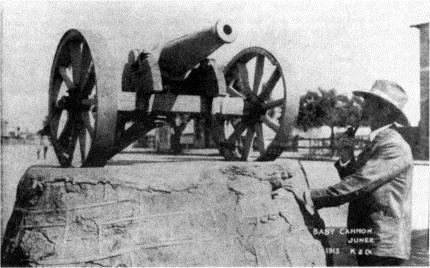
ARTILLERY REGISTER |
|||||||||||||||||||||||
|
|
||||||||||||||||||||||
| Historical Specifics: | The piece of ordnance is of a design known as a 'Soda Bottle' Cannon, based on a design by John Dahlgreen for the United States Navy, whose invention of the gun brought him into prominence in 1847. Its chief peculiarity consists in having less metal between the trunnions and muzzle than ordinary cannons, whilst the extra weight is put at the breech, where the real resistance is required. Technically described, the gun is a 3-pounder, its calibre is 2 inches and its weight is 3cwt, 68lbs. Its breech is very substantial, having about six inches of solid metal behind it, whilst there is 3.5 inches round the chamber, 4.5 inches at the trunnions and 2 inches at the muzzle
The patterns for the cannon were all made at the Pioneer Foundry. As a casting, it is a credit to the establishment, the town and more particularly to the head moulder Mr Ian Mathieson, who made the mould and superintended the casting. Two brass plates are fixed into the cannon. One reads 'Bobs', and the other 'Presented to the town of Junee by the makers, Messrs Cohoe and Walster, in commemoration of British victories in South Africa. A.D, 1900, D. Benjamin, Mayor'. The cannon was fired a number of times, first a test firing at the Foundry, on 8th June 1900, in the presence of the Mayor and some notable citizens. It was again fired from the top of Kemp St. to celebrate the relief of Mafeking and in 1901, a salute of 81 guns was fired, from the same location, to mark the death of Queen Victoria. It was then set on top of a stone platform in the square in front Junee Railway Station, where it stood for many years, and was always the assembly point for meetings and processions, which always started from 'The Cannon'. It was later shifted to a new position in Broadway, about where the Memorial Clock now stands. It stood there for many years, until time and the weather took their toll of the wooden spoked wheels and under carriage. It was then taken to the Council yard where it lay (one report indicates it was on its way to the local tip) until Mr Bill Walster was given possession of it and it was taken to his property 'Jesmond', on Bullocky Hill. After his death and the sale of the property, his nephew David Walster, took it to his home. In 2004 David Walster presented the gun to the Junee Council and it is presently displayed in the Liquorice Factory. |
||||||||||||||||||||||
| General Information on Gun Type: | |||||||||||||||||||||||
| Additional Photos: |
|
||||||||||||||||||||||
 |
|||||||||||||||||||||||


